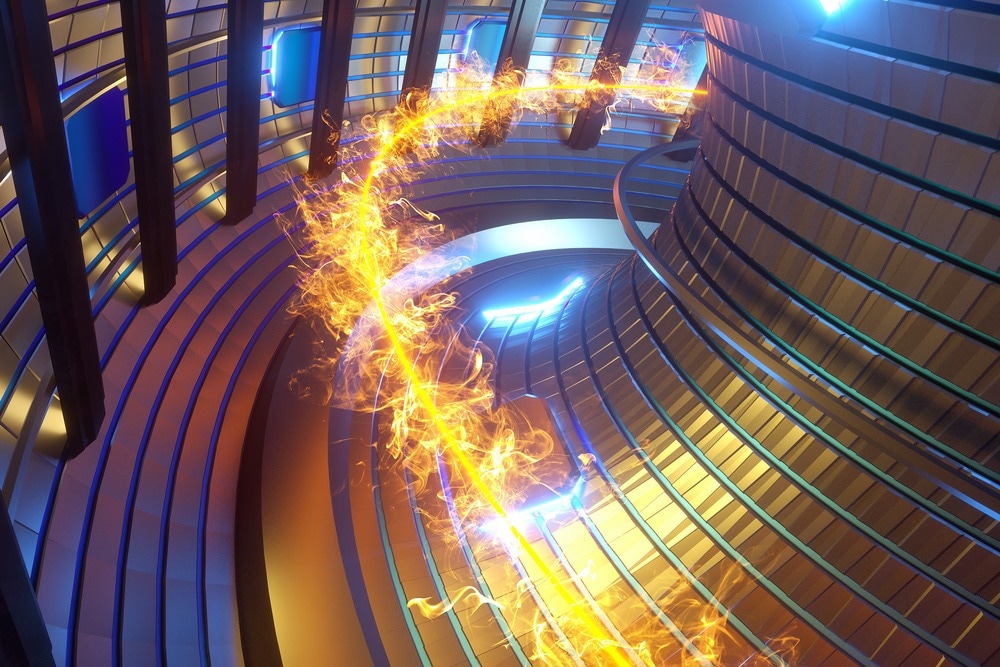As science and engineering advance, innovative robotic technologies are being utilized to assist all areas of the industrial sector, including new ways to generate energy.

Image Credit: Marko Aliaksandr/Shutterstock.com
Because of their diverse applications, robotic systems are used heavily in nuclear fusion applications to perform tasks in high-risk areas, retrieving data that would be impossible to obtain with humans alone and lowering maintenance costs.
What is Fusion Technology?
Since understanding the nuclear fusion concept in the early 1900s, scientists and engineers have been on a mission to reproduce and harness the power of nuclear fusion.
Scientists believe that nuclear fusion could be recreated on a large scale and that it has the potential to supply nearly endless safe, clean and economical energy to satisfy global demand.
Fusion fuel has the potential to provide four times the energy per kilogram of fuel as compared to fission and roughly four million times the energy per kilogram when compared to burning oil or coal. Furthermore, since fusion is difficult to initiate and sustain, there is little danger of a runaway reaction or nuclear plant meltdown.
It is also crucial to consider that nuclear fusion, like fission, emits no carbon dioxide or other greenhouse gases, suggesting that it might be a long-term low-carbon energy source.
Role of Robotics in the Energy Sector
Robotics is revolutionizing practically every field, including the power sector. Companies in the energy sector are utilizing robots to increase efficacy, improve accuracy, and lower costs associated with energy production and infrastructure monitoring.
Designs and technology for renewable energy systems are evolving rapidly. As a result, robotic systems are becoming crucial in the production of numerous forms of energy-based hardware, such as wind turbines and solar panels.
Like so many others, the energy industry is increasingly reliant on automation. Energy corporations also use robots to examine equipment for maintenance and safety. These inspections are required for almost all types of energy hardware, from pipes to turbines to power distribution lines.
Artificial intelligence, an emerging technology that is gaining a lot of traction, offers the added benefit of automating the decision-making process, with decision-making undertaken by specialized models trained on a vast amount of data.
Application of Robotics in Fusion Technology
Robotics has become a critical component in making nuclear fusion possible. Inspections, maintenance, and repair of nuclear fusion reactors are frequently required in regions with very high radiation levels.
To lower staff occupational radiation exposure, robotic systems for remote handling have already been developed, assessed, and successfully utilized in nuclear fusion plants.
Robotics can enhance plant availability by reducing downtime during shutdowns and managing tasks effectively while the fusion reactor is running. Robotics could help reduce plant maintenance durations by performing tasks in controlled areas, avoiding the necessity of human entry, or prepping the workspace to allow human operators to work more rapidly.
In experiments conducted at Culham Science Centre (CSC) near Oxford, a state-of-the-art laser-welding robot referred to as the "snake" was developed by the robotics research center at the United Kingdom Atomic Energy Authority (UKAEA).
The robot demonstrated its ability to function effectively within a nuclear fusion plant. The snake was created to address the issue of connecting pipes within nuclear fusion reactors.
Due to the hazardous nature of the tasks associated with nuclear fusion reactors, the work has to be performed remotely. The snake, which has now been patented, was created by UKAEA's Remote Applications in Challenging Environments (RACE) program. The snake will be supplied as an element of the EURO fusion's DEMO program and can be remotely operated within hazardous environments of a nuclear fusion plant without ever being touched by humans. It also has the added benefit of working effectively in pipelines packed together with very little room for access.
Future of Robotics in the Fusion Sector
The prospect of future nuclear fusion research may be dependent on hot robotics, which are robots crafted to access areas where people cannot go.
How robots may be capable of entering the extreme conditions within nuclear reactors and will be able to carry out indispensable maintenance operations that humans are incapable of performing but which are required to keep nuclear reactors running.
The energy sector as a whole is undergoing a substantial shift due to the increased use of robotics. The impact of these innovations on the future of energy production is likely to lead to increased productivity, enhanced durability, quality, and high-cost savings. Owing to these reasons and more, energy organizations are increasingly embracing robotics.
References and Further Reading
UKAEA (2022). Fusion robot at the ready for Blackbird Leys Festival. GOV.UK. Available at: https://www.gov.uk/government/news/fusion-robot-at-the-ready-for-blackbird-leys-festival
Barbarino, M. (2022). What is Nuclear Fusion? International Atomic Energy Agency. Available at: https://www.iaea.org/newscenter/news/what-is-nuclear-fusion
Parmar, P. (2022). Robotics In Energy Sector. Go Roboted. Available at: https://goroboted.com/robotics-in-energy-sector
Whittaker, R. (2022). Robotic snake at Culham solves fusion energy pipework challenge. Oxford Mail. Available at: https://www.oxfordmail.co.uk/news/20186082.robotic-snake-culham-solves-fusion-energy-pipework-challenge
Folk, E. (2019). What Robotics Mean for the Future of Energy. Green Journal. Available at: https://www.greenjournal.co.uk/2019/04/what-robotics-mean-for-the-future-of-energy
Disclaimer: The views expressed here are those of the author expressed in their private capacity and do not necessarily represent the views of AZoM.com Limited T/A AZoNetwork the owner and operator of this website. This disclaimer forms part of the Terms and conditions of use of this website.